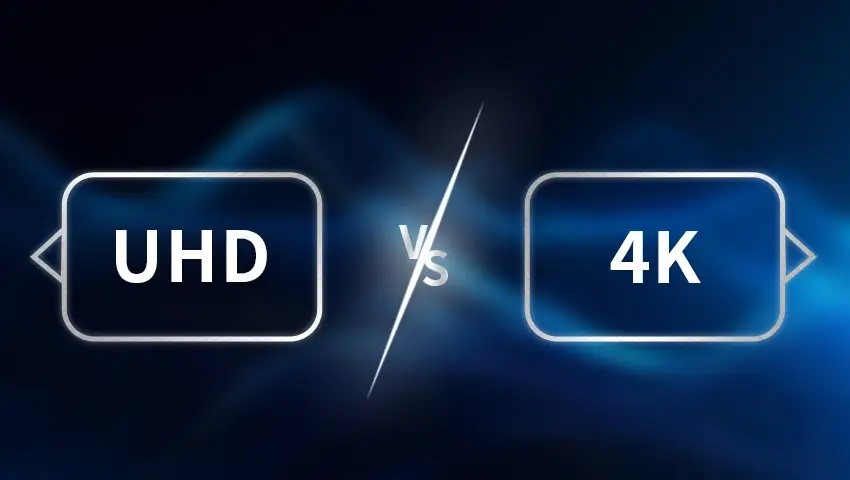As display technology advances, the debate around “UHD vs 4K” continues to grow. Whether for home TVs or cinematic displays, both UHD and 4K resolutions are becoming standard, yet these terms are often used interchangeably, creating confusion among consumers.
In this blog, we’ll explore the key differences between UHD and 4K, breaking down their impact on image quality, screen compatibility, color depth, and more to help you make the best choice for your viewing needs.
Contents
UHD vs 4K: Understanding the Basics
The journey to understanding UHD and 4K begins with their definitions. UHD, a term coined by the consumer electronics industry, refers to a resolution of 3840 x 2160 pixels, effectively quadrupling the pixel count of Full HD (1920 x 1080 pixels). On the other hand, 4K, originating from the digital cinema industry, boasts a resolution of 4096 x 2160 pixels, offering a slightly wider aspect ratio due to its 17:9 dimensions compared to UHD’s 16:9.
This distinction, while subtle, is crucial. Marketers often use “4K” and “UHD” interchangeably, which muddies the waters for consumers. The reality is, most 4K TVs on the market are actually UHD, not true 4K, a fact that can be disappointing for those seeking the higher cinema-standard resolution they expect from the term “4K”.
Resolution and Pixel Differences Between UHD and 4K
When comparing UHD and 4K, resolution is just the beginning. The difference in pixel count, though seemingly minor, has a significant impact on image quality. UHD’s 3840 x 2160 pixels provide a substantial increase in detail and clarity, especially on larger screens or projection systems. In contrast, 4K’s 4096 x 2160 pixels offer an even greater level of detail, which is particularly beneficial for professional and cinematic use.
Aspect ratio also plays a pivotal role. UHD’s 16:9 aspect ratio is ubiquitous across most consumer devices, making it perfect for home viewing. In contrast, 4K’s 17:9 ratio provides a more cinematic feel, which is why it’s often used in professional projectors and cinema screens.
Color and bit depth further differentiate UHD and 4K. Most UHD displays support 8-bit color, displaying 16.7 million colors, while many premium models offer 10-bit color, capable of displaying over a billion colors. True 4K displays often support higher bit depth and broader color gamuts, resulting in richer colors and smoother gradients.
Frame rate and bandwidth requirements also set UHD and 4K apart. True 4K requires more bandwidth due to its higher pixel count and broader color space, which can be a limiting factor for streaming services and live broadcasts. This is why much of the content on platforms like Netflix and YouTube, even when labeled as 4K, is actually UHD.
Choosing UHD or 4K for Home Viewing and Professional Use
Pixel density, measured in megapixels (MP), significantly influences image quality. While both UHD and 4K boast around 8.3 million pixels, the distribution and density of these pixels make a substantial difference. For gamers and streamers, the decision between UHD and 4K often comes down to frame rates and input lag. Most gaming consoles and streaming devices support UHD, but achieving true 4K gaming requires a powerful setup with a high-refresh-rate monitor or TV.
Enhancing Visuals: 4K HDR vs. UHD
Adding another layer to the UHD vs 4K debate is High Dynamic Range (HDR). HDR enhances the visual experience by expanding the range of colors and contrast beyond what standard dynamic range (SDR) can offer. 4K HDR combines the resolution of 4K with the dynamic range capabilities of HDR, resulting in brighter whites, deeper blacks, and more vibrant colors. This increased dynamic range and color depth provide a more immersive and lifelike image.
Future of 4K/UHD Resolution
The future of 4K/UHD resolution is bright, with emerging trends and innovations shaping the landscape of display technology. The integration of HDR with 4K/UHD is becoming increasingly popular, offering a more dynamic and engaging viewing experience. The development of 4K/UHD streaming services is also changing content consumption, providing viewers with unparalleled detail and clarity.
Furthermore, 4K/UHD plays a significant role in virtual reality (VR) and augmented reality (AR), enhancing the user experience by creating more convincing and immersive virtual environments. Lastly, the advent of 4K/UHD cameras is driving innovations in content creation, making high-quality content more accessible than ever before.
Conclusion
In the debate between UHD vs 4K resolution, there is no one-size-fits-all answer. The choice depends on the specific use case and the user’s needs. For home entertainment, UHD often strikes a balance between quality and practicality. However, for professional and cinematic applications, the true 4K resolution offers a superior viewing experience.





